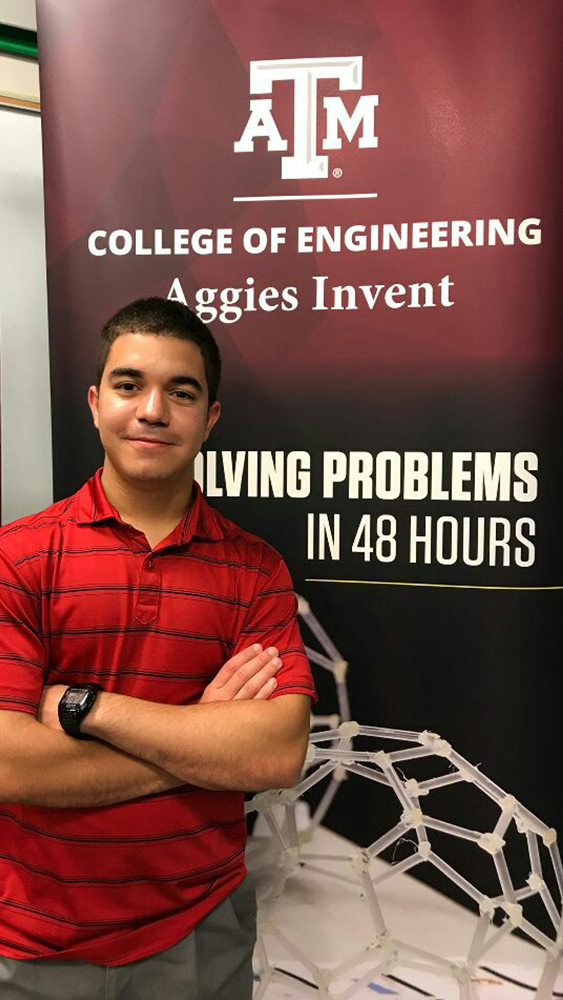
Hector Garcia ’20 is a biomedical engineering student who participated in the Grand Challenge Scholars Program (GCSP). The selective, three-year program gives engineering students the opportunity to solve one of the 14 Grand Challenges for Engineers in the 21st Century. Applications are currently open until Sept. 15, 2019.
Q: Tell us about yourself. Where are you from, and why did you choose engineering Texas A&M?
A: I was born and raised in Cuba until the age of 15 when my parents and I moved to the United States, and we have lived in Houston since then. I studied at Elsik High School, and there was great enthusiasm among my classmates to come to Texas A&M University.
I chose Texas A&M because it is nationally recognized as having one of the best engineering programs. Engineering is the largest program in the university, and it offers students the tools needed to succeed. A former Aggie went to my high school to talk about Texas A&M’s engineering program, and I haven’t forgotten when he mentioned that the engineering program has partnered with several big companies that facilitate students finding summer internships and jobs.
Q: How did you find out about the Grand Challenge Scholars Program?
A: I entered Texas A&M with the mindset of being part of something important and long-lasting. I was on the lookout for organizations and events where I could make a difference. One day I got an email advertising the Grand Challenge Scholars Program (GSCP), and I became interested in the idea of solving the “biggest challenges facing humanity in the 21st century.”
Q: What is the single most important lesson that you’ve learned by participating in this program?
A: The single most important lesson that I have learned is that society needs to create and empower leaders to tackle the challenges that current and future generations may face. Before entering this program, I was unaware of the 14 grand challenges. I thought about what was left to invent. However, working in research opened my eyes to many unsolved, existing problems. In my research lab, I was only targeting a very specific problem, and that itself has opened the doors to a few other problems that haven’t been solved.

Q: The Grand Challenge Scholars Program allows students to work on real-world problems that are affecting people around the world. Can you talk a little bit about this experience?
A: GCSP prepares students in five components: research, interdisciplinary, entrepreneurship, global perspective and service-learning. An individual deciding to tackle any of the grand challenges must possess those skills.
I primarily worked in the Laboratory for Control, Robotics and Automation. My team developed a virtual reality enhanced upper limb exoskeleton for rehabilitation of stroke patients. Many people around the world suffer from arm paralysis, and despite the best rehabilitation techniques, oftentimes patients aren’t able to regain the amount of strength needed in order to operate a robotic arm. We’re trying to create a device that trains patients who have arm paralysis to be able to concentrate and move a robotic arm.
In the lab, we tested patients wearing an electroencephalogram (EEG) device that outputs their brainwaves in real time, so we knew if they were putting enough effort to move the robotic arm. Once the patient’s brainwaves reached a point where the patient could no longer increase the signal amplitude, we used that value as a starting point so that the arm moved at that amplitude during the first session, but their input signal gradually increased in posterior session until the patient matched the required input brain signal to move their own arm.
This research project had a blend of all the previous factors. The global perspective is important since it is good to test subjects from different places and know how affordable to make the device. The service-learning is useful when explaining your device to the general public.
Q: How did you approach the challenge you selected, and what do you hope to accomplish?
A: The grand challenge I chose — reverse engineering the brain — came about due to two factors. First, I read a book called “Physics of the Future,” and the author extensively covered this topic. Second, I am interested in pursuing medicine after college, and this grand challenge seemed like a good fit for my future career.
I hope to help a professor publish a paper that illuminates new aspects of artificial intelligence. The science builds upon itself, and publishing a paper is a way for others to use our results and take it one step further.
Q: Did you ever think that you would be able to participate in research as an undergrad?
A: No. I thought that participating in research as an undergrad would be more difficult. I imagined students who were doing research as possessing special skills or sufficient knowledge. However, all it took was for me to email the professors who had research projects I was interested in. They paired me up with a graduate student who taught me the skills needed so I could contribute to the project.
Q: Is there anything you’d like to add?
A: My three years in GCSP have been fantastic. It has given me the opportunity to work on cutting-edge research and prepare for my future professional career. This program brings together several professions such as engineering, medicine and business. This experience taught me to look at engineering from a different lens, and encouraged me to think broadly and deeply about the challenges that our society faces. I put to use my academic skills and learned soft skills such as teamwork, communication, problem-solving and work ethics.